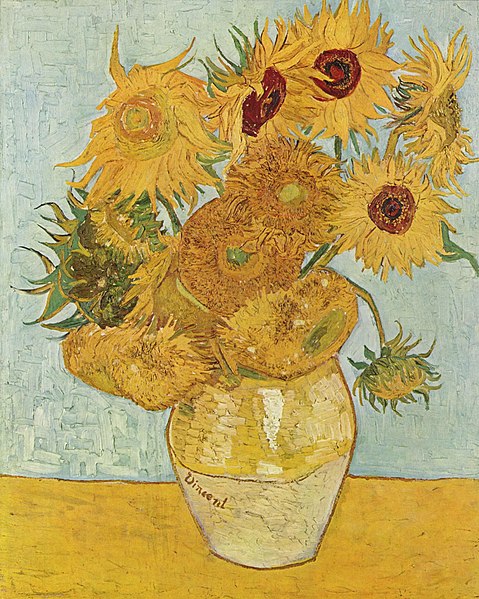
Bio Data of Vincent Willem van Gogh
Birth name: Vincent Willem van Gogh
Born : 30 March 1853, Zundert, Netherlands
Died : 29 July 1890 (aged 37)
Auvers-sur-Oise, France
Nationality: Dutch
Field : Painter
Movement : Post-impressionism
Works : The Potato Eaters, Sunflowers, The Starry Night, Irises,
Portrait of Dr. Gachet
Title Deutsch: Stilleben mit 12 Sonnenblumen
English: Vase with 12 sunflowers
Year 1888(1888)
Technique Oil on canvas
Dimensions 91 × 72 cm (35.83 × 28.35 in)
Current location Deutsch: Neue Pinakothek
Sunflowers (original title, in French: Tournesols) are the subject of two series of still life paintings by the Dutch painter Vincent van Gogh. The earlier series executed in Paris in 1887 gives the flowers lying on the ground, while the second set executed a year later in Arles shows bouquets of sunflowers in a vase. In the artist's mind both sets were linked by the name of his friend Paul Gauguin, who acquired two of the Paris versions. About eight months later Van Gogh hoped to welcome and to impress Gauguin again with Sunflowers, now part of the painted décoration he prepared for the guestroom of his Yellow House where Gauguin was supposed to stay in Arles. After Gauguin's departure, Van Gogh imagined the two major versions as wings of the Berceuse Triptych, and finally he included them in his exhibit at Les XX in Bruxelles.
As Van Gogh anticipated in 1889, the Sunflowers finally became his, and served — combined with self-portraits — as his artistical arms and alter ego up to the present day: no retrospective Van Gogh exhibition since 1901 voluntarily missed including them, and a wealth of forgeries as well as record-setting price paid at auction acknowledges their public success: Perhaps, because Van Gogh's Sunflowers are more than his or him — they may be considered, as Gauguin put it, the flower.
In January 1889, when Van Gogh had just finished the first repetitions of the Berceuse and the Sunflowers pendants, he told his brother Theo: I picture to myself these same canvases between those of the sunflowers, which would thus form torches or candelabra beside them, the same size, and so the whole would be composed of seven or nine canvases.[11] A definite hint for the arrangement of the triptych is supplied by Van Gogh's sketch in a letter of July 1889.[12]
Sunflowers, friendship and gratitude
Van Gogh began painting in late summer 1888 and continued into the following year. One went to decorate his friend Paul Gauguin's bedroom. The paintings show sunflowers in all stages of life, from full bloom to withering. The paintings were considered innovative for their use of the yellow spectrum, partly because newly invented pigments made new colours possible.
In a letter to his brother Theo,[13] Van Gogh wrote:
"It is a kind of painting that rather changes in character, and takes on a richness the longer you look at it. Besides, you know, Gauguin likes them extraordinarily. He said to me among other things - 'That...it's...the flower.' You know that the peony is Jeannin's, the hollyhock belongs to Quost, but the sunflower is somewhat my own."
A Brief Understanding of the Sunflower Paintings.
Upon looking at these paintings one begins to notice aspects that seem to flow
from one piece to another. The colors are vibrant and express emotions typically associated with the life of sunflowers: bright yellows of the full bloom to arid browns of wilting and death; all of the stages woven through these polar opposites are presented. Perhaps this very technique is what draws one into the painting; the fulfillment of seeing all angles of the spectrum of life and in turn reaching a deeper understanding of how all living things are tied together.
There are many pieces within this series of paintings (each is clearly identifiable as a Van Gogh work) in which there are only minor differences that separate them.
Many thanks for posting the above. I do hope your colleagues will become acquainted with the picture and at least something about Van Gogh.
ReplyDelete